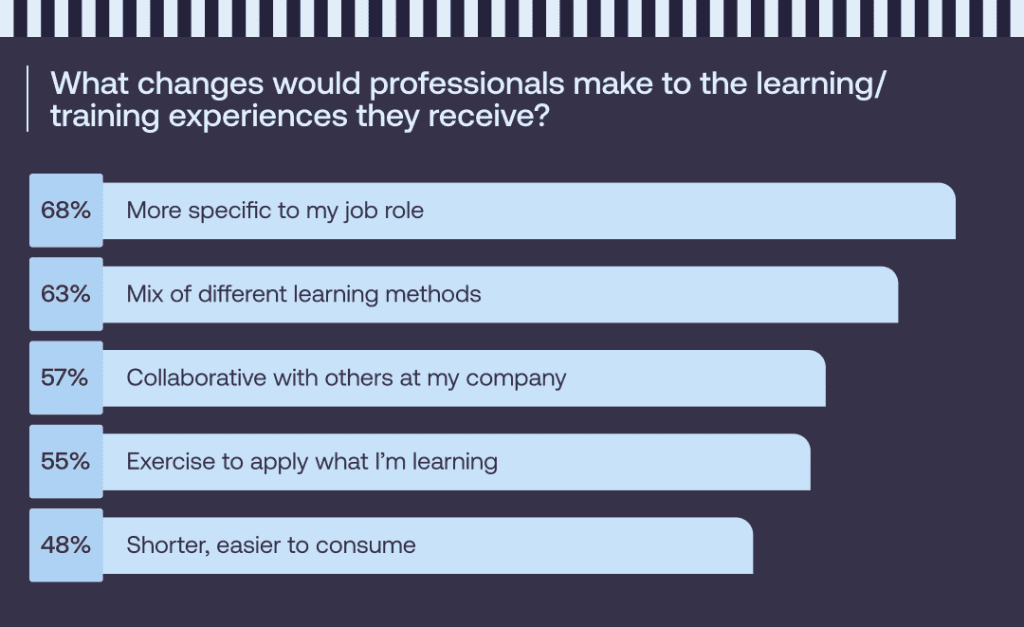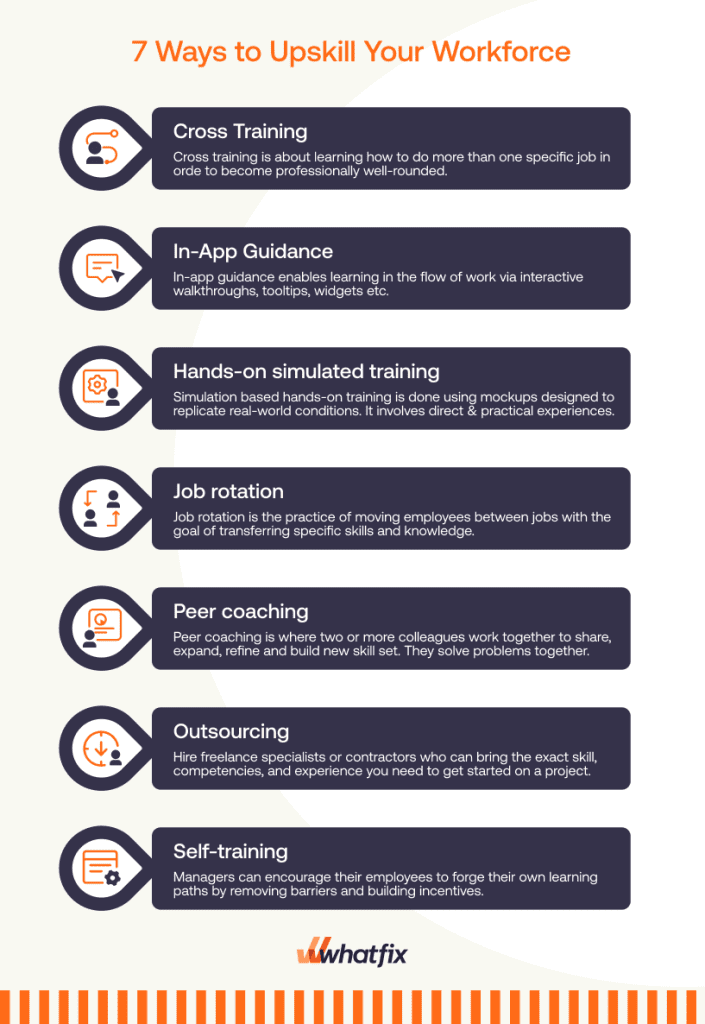
Digital Upskilling: How to Enable Your Employees
- Published: January 19, 2023
- Modified: May 10, 2024

Digital transformation has accelerated productivity across all sectors, from enabling previously unimagined oversight of complex processes to eliminating repetitive tasks through automation.
However, as technology is adopted faster than workforces can keep up with, workforces need new skills to understand and utilize the new digital workplace.
In fact, a Microsoft report found that 65% of hiring managers worldwide report difficulty finding qualified digital talent due to a lack of digital skills.
The digital skills gap is real, preventing organizations worldwide from maximizing digital transformation and leveraging new technologies to achieve business outcomes. Organizations must maintain a highly digital-literate workforce to stay ahead of the curve, which can be accomplished through digital upskilling.
What Is Upskilling?
Upskilling is the process of learning new skills and acquiring relevant competencies needed for today’s work environment as well as for the near future. It focuses on improving employees’ skill sets, usually through continuous employee training programs, to help them advance in their jobs and find more opportunities within the company in the future.
To be competitive in the digital age, employees must have a learning-for-life mindset and a willingness to acquire new competencies required by the fast-paced marketplace. On the other hand, organizations must make digital upskilling a priority element of their internal digital transformation strategy.
The Need For Upskilling In the Digital Age
In the digital age, the need for upskilling is driven by several critical factors that influence both the viability of organizations and the career trajectories of individuals. Here’s a detailed explanation of why upskilling is essential.
1. Rapid technological advancements
According to a report by PwC, one in three jobs will likely be disrupted in the next decade because of technological changes each day.
The pace at which new technologies are implemented within organizations is accelerating significantly, transforming the landscape of nearly every industry. Once considered emergent, technologies such as cloud computing, big data, and blockchain are now mainstream and essential for businesses to remain competitive.
As these technologies evolve, the skill sets required to work with them also change effectively. Organizations and individuals must commit to continual learning to upskill with the latest tools, platforms, and technologies. This ensures that employees and businesses can leverage new technologies to drive innovation, streamline operations, and enhance service offerings.
2. Automation and AI
The rise of automation and AI is reshaping the workforce in profound ways. Manual tasks are increasingly automated, requiring employees to adapt by developing new skills. For instance, AI-driven analytics tools can automate complex data analysis processes, but skilled analysts must interpret these results and make informed decisions.
Upskilling in areas such as AI management, oversight, and application in business processes is crucial for employees to complement these technologies rather than be replaced by them. This helps individuals enhance their career longevity and enables organizations to harness the full potential of AI and automation technologies.
3. Job market competitiveness
As employers seek candidates with the latest technical competencies and soft skills such as adaptability, critical thinking, and advanced communication, existing employees must upskill to meet these demands. Upskilling becomes a key differentiator in career progression, with proactive learners more likely to seize growth opportunities and secure positions of leadership. Additionally, organizations emphasizing upskilling attract top talent and are better positioned to retain high-performing employees.
4. Closing the skill gap
There is a noticeable gap between job seekers’ skills and the capabilities employers need, particularly in sectors experiencing rapid technological changes. This skills gap hinders organizational growth and innovation as companies need help finding candidates with the required competencies.
By investing in continuous upskilling initiatives, organizations can work on closing this gap, ensuring their workforce is proficient in the latest industry-relevant skills. Such initiatives prepare businesses to tackle current challenges more effectively and future-proof their workforce against upcoming industry shifts.
Upskilling vs. Reskilling
While both are essential areas of employee development and organizational growth, they serve different purposes and address different needs. Here’s a detailed explanation of the differences between upskilling and reskilling.
Upskilling refers to the process of improving or expanding an individual’s existing skill set to enhance their performance in their current role. It involves learning additional skills or enhancing current abilities to keep pace with technological advancements and changing job requirements within the same area of work. Upskilling is typically focused on progression rather than change, aiming to make an employee more proficient, efficient, and valuable in their current position.
Examples of upskilling:
- An IT professional learning advanced cybersecurity techniques to handle emerging security challenges.
- A digital marketer gaining expertise in new social media tools and analytics software to enhance marketing campaigns.
- A manufacturing worker trained on newer, more sophisticated machinery that has been integrated into the production line.
Reskilling is the process of learning new skills so you can do a different job or training people to do a different job. It involves a significant shift from one job role to another, requiring the individual to learn a completely new set of skills. Reskilling is often driven by automation, downsizing, or significant industry shifts that make certain skills or roles obsolete. It’s about transition and transformation, enabling individuals to adapt to new job environments or roles that are starkly different from their previous ones.
Examples of reskilling:
- An assembly line worker whose job has been automated learns software programming to move into a tech-based role within the company.
- A retail sales associate moving into a customer service role in an e-commerce setting, requiring new skills in digital communication and order management software.
- A financial analyst shifting to a data science career requiring extensive training in big data analytics, programming, and machine learning.
| Upskilling | Reskilling | |
| Purpose and focus | Enhances and adds to existing skills to improve performance and productivity in the current role. | Equips individuals with new skills for a different role, often in response to changing job demands or industry restructuring. |
| Driven by | Driven by the need to stay current with industry trends, technological advancements, and increasing job complexity within the same field. | Driven by fundamental changes in the job market, organizational restructuring, or the need to pivot to new career opportunities due to job obsolescence. |
| Outcome | Employees become more competent and can take on more complex or a greater variety of tasks within their current roles. | Employees transition to different roles or career paths, often within new departments or industries. |
| Organizational benefits | Helps improve the quality of work and productivity without significant changes to workforce composition. | Helps retain valued employees by transitioning them into emerging roles or sectors, thus adapting to industry changes without the need for extensive new hires. |

The Benefits of Upskilling for Employers and Employees
Let’s take a closer look at some of the ways the right upskilling program can deliver greater outcomes and ROI.
Upskilling benefits for employees
- Enhanced career prospects: Upskilling enables employees to acquire new skills and knowledge in high demand, making them more competitive and valuable in the job market. This increased competence can open doors to promotions, higher-paying roles, and more challenging positions within their current organization or elsewhere. As employees expand their skill sets, they also widen their career options and enhance their visibility and attractiveness to potential employers.
- Job security: Upskilling enables employees to acquire new skills and knowledge that are in high demand, making them more competitive and valuable in the job market. This increased competence can open doors to promotions, higher-paying roles, and more challenging positions within their current organization or elsewhere. As employees expand their skill sets, they also widen their career options and enhance their visibility and attractiveness to potential employers.
- Increased job satisfaction: Learning new skills can rejuvenate interest in a role and make daily tasks more engaging. As employees become more proficient and can handle more complex challenges, they often experience a greater sense of accomplishment and confidence. Moreover, companies investing in upskilling value their employees highly, contributing to a positive work environment where employees feel appreciated and valued.
- Greater independence: With advanced skills, employees can operate more autonomously and take on additional responsibilities. They become less dependent on others for solving routine problems and can innovate more freely. This level of independence enhances their effectiveness and positions them as leaders and go-to experts within their teams. It empowers them to drive projects, make decisions, and lead initiatives, which can further their career and personal development.
- Personal growth: Beyond professional development, upskilling contributes to personal growth. Learning is a fulfilling activity that stimulates the mind and boosts mental health. Employees who engage in continuous learning often enjoy acquiring new knowledge and skills, which keeps them mentally active and personally fulfilled. This ongoing development can lead to discovering new passions or deepening existing ones, enriching their personal lives alongside their professional ones.
Upskilling benefits for companies
- Improved productivity: Upskilling often involves introducing employees to new tools and methods that automate routine tasks, allowing them to focus on more complex aspects of their jobs that require critical thinking and decision-making. This not only speeds up work processes but also reduces the likelihood of errors, resulting in a smoother, more efficient operation overall. As employees become more competent, they can take on additional responsibilities, reducing bottlenecks and improving work flow across departments.
- Innovation: Employees trained in the latest technologies and methodologies are more likely to identify opportunities for improvement and innovation within the organization. Upskilled employees bring fresh perspectives and ideas that can lead to developing new products, services, or processes that drive business growth. Furthermore, employees encouraged to learn and experiment are often more engaged and motivated, which is conducive to creative problem-solving and innovation. This continuous influx of new ideas and approaches helps keep the company at the cutting edge of its industry.
- Higher retention rate: Ensuring high levels of employee satisfaction across your business is crucial for maintaining high employee performance and low turnover rates. According to a study by Willis Towers Watson, 70% of “high-retention-risk” employees want to leave because they see no future advancement in their current job.” To ensure high employee satisfaction, organizations must make employees feel valued. Upskilling is a great way to show your employees that you care about their progression and make them feel there’s something ‘in it for them,’ which, in turn, boosts employee productivity, satisfaction, and retention rates within an organization.
- Adaptability: By continuously updating employees’ skills, employers ensure that their workforce can handle new challenges, technologies, and shifts in the business landscape. This readiness to adapt helps the organization navigate disruptions more effectively and enables it to seize new opportunities more swiftly than competitors. An adaptable workforce can more easily adjust to internal changes, such as restructurings or shifts in strategic direction, minimizing downtime and maintaining productivity.
How to Develop an Upskilling strategy for Your Workforce
Anticipating the right skills for the future, developing effective training programs, and building a culture of continuous learning and development with the right edtech enables organizations to successfully upskill their workforce for the digital era.
Here are a few steps to help you plan effective upskilling for your workforce:
1. Conduct a Skill Gap Analysis
A skills gap analysis is an assessment conducted by HR teams to determine whether or not their workforce’s current skills meet the overall needs of the company. A skill gap analysis, as an output, gives you a list of skills employees already have, need to improve, and need to develop.
From there, you can fill in the skill gap using online courses and training programs to upskill your workforce and build a team of skilled workers who are able to meet your overall company’s objectives.
✓ Thank you, the template will be sent to your email
2. Build upskilling into your employee development plans
According to the World Economic Forum, 6 in 10 workers will require training before 2027, but only half of workers are seen to have access to adequate training opportunities today.
To provide training and upskilling opportunities for their employees, organizations can align their employee development plans with future workplace skills that support the overall company’s objectives, as well as meet every employee’s unique development needs.
These development plans will empower employees to gain the knowledge and skills necessary to be proficient and productive in their role and be prepared for the future by equipping themselves with desired workplace skills.
Remember, any goals you set for employees should be specific, obtainable yet challenging, and time-bound. For instance, a goal could be: every employee in the sales department becomes proficient in two critical future skills within a period of 6 months.
3. Choose your employee training method
In Econsultancy’s survey report, 63% of respondents said if they could change their training, they would add a wider mix of learning methods.

Employees often benefit from a mixed-method training approach because it allows them to engage with material in multiple ways, which can reinforce learning and accommodate individual preferences.
For example, eLearning modules provide flexibility and convenience, allowing learners to access training materials anytime and anywhere, on-the-job training offers practical experience where employees can apply learned concepts in real-world scenarios, instructor-led training facilitates interactive discussions, hands-on activities, and immediate feedback, crucial for complex topics that require deeper understanding, and so on.
To find the best employee training method or methods that work the best for your employees, L&D teams must understand employee learning styles and consider other factors such as their training objectives, goals, cost, and timeline.
4. Utilize technology
Leverage employee training software to deliver effective upskilling programs. These software tools allow you to create engaging training modules, ensure compliance and security, track employee engagement, analyze performance, and gather feedback. Let’s have a look at the two most popular learning and training software:
- Learning Management System (LMS): A corporate LMS handles all aspects of employee training – from creating to delivering to tracking the training material. It helps identify and assess both individual and organizational learning goals, track employee progress towards meeting those goals and collect data for improving the learning process.
- Digital Adoption Platform (DAP): A training software that integrates with different enterprise applications to help users learn in the flow of work. DAP creates a contextual task list containing interactive walkthroughs, videos, and self-help menus for users to guide them through every aspect of an application. Using DAPs as your training software empowers employees to upskill themselves on the latest tools, applications, or processes without disrupting their workflow and productivity.
Software clicks better with Whatfix's digital adoption platform
Enable your employees with in-app guidance, self-help support, process changes alerts, pop-ups for department announcements, and field validations to improve data accuracy.
5. Providing learning in the flow of work
The “learning in the flow of work” approach integrates learning directly into the daily tasks and workflows of employees. This method allows for immediate application of new skills, which enhances retention and relevance. By delivering learning in the context of work, this strategy minimizes disruption and removes the need for employees to step away from their workstations to participate in traditional learning environments. It offers a seamless, just-in-time learning experience that is both efficient and highly relevant to the tasks at hand.
Invest in a digital adoption platform (DAP) like Whatfix to deliver in-app guided learning in the flow of work. Whatfix provides contextual, in-app guidance and support that helps users navigate complex software without leaving their workflow, with in-app content like Tours, Flows, Task Lists, Field Validations, Smart Tips, Self Help, and more, all enabling employees with contextual guidance and support inside their workflows.

Whatfix is designed to accelerate proficiency with new software and systems, and support employees at the moment of need. Whatfix offers a powerful solution to deliver personalized, step-by-step guidance that is embedded directly into the daily workflows, ensuring that employees not only learn but also apply new skills effortlessly as part of their regular activities.
6. Follow Up and Track Progress
The last step is to evaluate the entire upskilling program to determine if it was successful and met its objectives. As mentioned earlier, employee training software allows you to measure the effectiveness of your training and development programs. Monitoring KPIs such as course completion rates, training progression rates, assessment scores, lowering skill gap analysis, improving proficiency or productivity, etc. helps determine training effectiveness and knowledge or skill acquisition by the end of your upskilling program.
Consider using the following metrics to measure your training effectiveness:
- Employee feedback: Post-training employee feedback helps determine whether or not the training helped your employees learn new skills.
- Assessments: Tests, quizzes or demonstrations help evaluate the skills, knowledge, and learnings gained by employees after the upskilling training programs.
- Post-training job proficiency: Observe your employees to figure out whether or not they’re using the newly gained skills in their day-to-day tasks.
7 Ways to Upskill Your Workforce
There are various ways to upskill your workforce. You can pick and choose the most appropriate one depending on your organization’s needs (based on a skills gap analysis).

1. Cross-training
Allow employees to cross-train in other roles that require skillsets similar to their current job. Cross-training allows your employees to learn on the job and refine their skills, laying the groundwork for future mobility into evolving roles.
For instance, an account manager who demonstrates customer interaction skills could cross-train as a customer success manager. The role calls on similar skills but takes them to the next level. Then, that employee can bring enhanced customer success skills back to benefit their team and can also look for an opportunity to switch in the future.
2. In-app guidance
In-app guidance enables end-users with interactive, contextual assistance and support through a combination of in-app elements. It may include interactive walkthroughs, tooltips, checklists, self-help wikis, and other UX elements that help to educate users on product functionality, drive engagement, provide contextual assistance, and achieve product adoption.
Whatfix is one such solution that specializes in helping businesses drive digital adoption and create a seamless training experience for users. It provides step-by-step instructions for key workflows. Users see these instructions as they follow the steps of a guided tour, learning about processes as they work.

See how Sophos used Whatfix’s digital adoption platform to enable its customers to find instant answers for its XG Firewall implementation questions, accelerate cybersecurity deployments for new customers, proactively stay ahead of complex security threats, and provide self-help support for users.
3. Hands-on simulated training
Hands-on simulation training is recognized as an exceptionally effective method for upskilling employees, particularly in complex or technical fields. This approach involves creating realistic work scenarios that closely mimic actual job conditions, allowing employees to gain practical experience in a controlled, risk-free environment. Such simulations enable employees to interact with the systems and tools they will use in their roles without the pressure of real-world consequences.
Additionally, hands-on simulated training enhances engagement by involving learners actively, which improves retention rates and helps employees gain confidence in their skills.
Implementing Whatfix’s no-code product Whatfix mirror, enables you to create sandbox environments for hands-on simulated training quickly. It allows employees to navigate the real systems they will use but in a controlled setting that eliminates any risk to actual data or operations. This is particularly beneficial for complex software applications where navigating the interface can be challenging. Whatfix further supports these environments with contextual guidance and interactive walkthroughs, which are integrated directly into the sandbox. This means that employees not only practice in an environment that mirrors their actual work scenarios but also receive real-time, step-by-step guidance tailored to their specific interactions and learning needs.
4. Job rotation
Job rotation involves moving employees through a series of job assignments in different departments or areas of the company. This strategy is particularly beneficial for broadening the skills and experiences of employees, exposing them to different facets of the business, and enhancing their understanding of the organization as a whole. By rotating through various roles, employees not only acquire a diverse set of skills but also gain valuable insights into how different units operate, how roles interconnect, and how their work impacts other parts of the business.
This method serves several upskilling objectives: it helps employees develop new technical skills specific to different roles, enhances their problem-solving and decision-making abilities by exposing them to new challenges, and improves adaptability by requiring them to adjust to various work environments and team dynamics.
Furthermore, job rotation fosters a more flexible workforce that can effectively manage broader responsibilities and fill in gaps as needed, which is especially valuable in times of organizational change or employee absences.
5. Peer-to-peer learning
Peer-to-peer learning is a collaborative method where employees partner to share knowledge, skills, and experiences to mutually enhance their professional development. This approach leverages the existing talents within the organization, creating a supportive learning environment that fosters continuous growth and development.
In peer coaching, colleagues work together through regular interactions, such as discussions, feedback sessions, and shared problem-solving experiences, enabling them to learn from each other’s strengths and insights.
The peer coaching method is particularly effective because it promotes a deeper, more personal learning experience. Coaches and learners are often on similar professional levels, which can reduce the intimidation and hierarchy that sometimes accompany traditional mentoring relationships. This setting encourages open communication, honest feedback, and mutual respect, making it easier for individuals to discuss challenges and explore solutions candidly.
6. Outsourcing
Outsourcing is a strategic approach to training when an organization lacks the in-house resources or expertise necessary to develop and deliver effective learning. By contracting with external providers, companies can access specialized training that is both high-quality and tailored to the specific needs of their workforce.
This method is particularly beneficial for organizations needing to quickly implement advanced or niche skills that are not within the realm of their current capabilities. Furthermore, outsourcing training allows organizations to focus on their core business operations without the burden of developing and managing complex training programs.
7. Self-training
Self-learning represents a highly flexible and individualized approach, allowing employees to take charge of their own professional development. This method enables individuals to learn new skills at their own pace and according to their own specific career needs. By engaging in self-learning, employees can explore a vast array of resources such as online courses, tutorials, webinars, and ebooks that are readily available on numerous platforms.
For organizations, encouraging self-learning among employees fosters a culture of continuous improvement and lifelong learning. Additionally, self-learning can be a cost-effective solution for businesses, minimizing the need for extensive in-house training resources while maximizing the potential for employee development.
Real-Life Examples of Corporate Upskilling Programs in 2024
To inspire your upskilling initiatives, here are some real-life examples of organizational strategies that have boosted productivity, improved problem-solving capabilities, and reduced training costs. Here are the highlights of these success stories:
1. AlphaSights
AlphaSights, a leading global provider of on-demand knowledge services, experienced rapid growth and needed to expand its training capabilities accordingly. The company realized that its traditional upskilling strategy of conducting in-person, presentation-based training, led solely by the L&D team, lacked relevance. As a result, employees lacked the motivation to complete training courses and the L&D team also didn’t have a way to track progress or measure the effectiveness of their material.
To overcome these challenges, AlphaSights employed a bold upskilling strategy and turned to the experts who knew their training needs best—their employees—and brought them into the course creation process with the help of 360Learning. With an easy-to-use authoring tool, SMEs from different departments like engineering or commercial, turned their knowledge into eLearning courses. The training content instantly became more role-specific, relevant, and engaging.
Ultimately, the company mobilized more than 300 employees—27% of their workforce—to become course authors and share their knowledge. Their course completion rate soared to 95%, with improved engagement and productivity. Using 360Learning, they can now consistently monitor progress and training results, which helps them prioritize training initiatives that best serve their business needs.
2. Amazon
In September 2021, Amazon committed $1.2 billion to provide 300,000 employees with access to education and skills training programs through 2025 as part of Amazon’s Upskilling 2025 pledge.
Through the Upskilling 2025 program, Amazon is focused on creating pathways to careers in future growing areas. Amazon continues to launch new training opportunities and expand on existing programs for employees across the U.S., including
- AWS Grow Our Own Talent: on-the-job training and job placement opportunities to Amazon employees and entry-level candidates with non-traditional backgrounds.
- Surge2IT: help entry-level IT employees across Amazon’s operations network pursue careers in higher-paying technical roles through self-paced learning resources.
- The UXDR Apprenticeship program: combines instructor-led training and real-world experience to offer employees the opportunity to learn and develop skills in research and design.
- Mechatronics and Robotics Apprenticeship Program: learn skills and technical knowledge to fulfill technical maintenance roles.
3. SupportWorks
Supportworks, a home services company, prioritized leadership development to enhance employee skills and cultivate a new generation of management. This initiative not only broadened their pool of potential future leaders but also fostered a company culture centered around employee growth.
In response to the challenges posed by the pandemic, including managing a hybrid workforce and integrating new technologies, Supportworks recognized the necessity of a hybrid learning strategy that catered to their employees.
To achieve this, the company adopted a blended learning approach for their ManagementU program, combining live, instructor-led sessions with self-paced online learning. This program was developed through the collaborative efforts of in-house experts, company leaders, and the L&D team. The curriculum covered a variety of topics, from recruitment and onboarding to communication strategies.
As a result, participants with different experiences and backgrounds get a baseline level of knowledge that they are more likely to retain and use. So, when the same learners attend in-person upskilling programs, they already have basic leadership skills and can pursue a new career path.
4. IBM
IBM made a global plan to provide 30 million people of all ages with new skills needed for the jobs of tomorrow by 2030. To achieve this goal, IBM announced a clear roadmap with more than 170 academic and industry partnerships. The plan relies on a broad combination of programs, and includes collaborations with universities, key government entities, and NGOs. In general, IBM’s efforts mobilize the private sector across the globe to open and expand opportunity pathways for underrepresented and historically disadvantaged communities.
5. Mastercard
In order to remain competitive, Mastercard wanted to create a learning culture that would encourage its employees to build new skills. They decided to use Degreed as a platform that offers personalized learning experiences, creates career pathways, and helps employees connect to the content relevant to them. There’s a breadth of content available on Degreed, including ‘bite-sized’ learning in the form of short articles, videos, and podcasts. This makes it easy for employees to engage with learning on the go.
Companies invest in new technologies to improve business processes and save time and money. However, if your employees are wasting too much time learning about those new technologies, then you might end up getting a very less return on your investment. Not to mention, employees are resistant to new technology when you’ve not created a culture of constant learning and innovation.
Whatfix DAP integrates with your new technologies to show employees how to use a technology to its full potential and produce better business results. DAPs break the resistance barriers by training your employees with interactive walkthroughs, giving them better access to information through Self Help, and guiding them through processes when they need help.
Intrigued to learn more? Book a free trial with us today to see how Whatfix can help build effective upskilling programs for your employees.

Above: Enable your employees with contextual user support and accelerate IT adoption with Whatfix's digital adoption platform.
The Whatfix Digital Adoption Platform empowers IT teams to create in-app guidance and self-service user support on all internal desktop, web, and mobile applications. Enable employees with Self Help, which overlays onto your CRM, HCM, ERP, CPQ, and other digital workplace applications. Self Help connects to your process and IT documentation, LMS, video tutorials, onboarding documents, and other IT support-related content to provide employees self-help, at the moment of need. Create additional in-app guidance and pop-ups to contextually guide users through applications and alert them to process changes.


